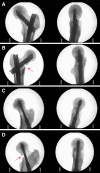Internal fixation of femoral neck fractures with posterior comminution: a biomechanical comparison of DHS® and Intertan nail®
- PMID: 21286918
- PMCID: PMC3193951
- DOI: 10.1007/s00264-010-1199-x
Internal fixation of femoral neck fractures with posterior comminution: a biomechanical comparison of DHS® and Intertan nail®
Abstract
Background and purpose: Internal fixation is a therapeutic mainstay for treatment of undisplaced femoral neck fractures and fractures without posterior comminution. The best treatment for unstable and comminuted fractures, however, remains controversial, especially in older patients. The present study was designed to assess the utility of the Intertan Nail® (IT) for stabilization of comminuted Pauwels type III fractures compared to dynamic hips screw (DHS).
Methods: Randomized on the basis of bone mineral density, 32 human femurs were assigned to four groups. Pauwels type III fractures were osteomized with a custom-made saw guide. In 16 specimens the posteromedial support was removed and all femurs were instrumented with an IT or a DHS. All constructs were tested with nondestructive axial loading to 700N, cyclical compression to 1,400N (10,000 cycles), and loading to failure. Outcome measures included number of survived cycles, mechanical stiffness, head displacement and load to failure.
Results: Postoperative mechanical stiffness and stiffness after cyclical loading were significantly reduced in all constructs regardless of the presence of a comminution defect (p = 0.02). Specimens stabilized with the IT had a lower construct displacement (IT, 8.5 ± 0.5 mm vs. DHS, 14.5 ± 2.2 mm; p = 0.007) and sustained higher failure loads (IT, 4929 ± 419 N vs. DHS, 3505 ± 453 N; p = 0.036) than the DHS constructs.
Interpretation: In comminuted Pauwels type III fractures, the fixation with the IT provided sufficient postoperative mechanical strength, comparable rate of femoral head displacement, and a similar tolerance of physiological loads compared to fractures without comminution. The absence of the posteromedial support in comminuted fractures tended to reduce the failure load regardless of the fixation method.
Figures




Similar articles
-
A comparative biomechanical analysis of fixation devices for unstable femoral neck fractures: the Intertan versus cannulated screws or a dynamic hip screw.J Trauma. 2011 Sep;71(3):625-34. doi: 10.1097/TA.0b013e31820e86e6. J Trauma. 2011. PMID: 21768904
-
Internal fixation of femoral neck fractures with posterior comminution: a biomechanical study.J Orthop Trauma. 1999 Mar-Apr;13(3):155-9. doi: 10.1097/00005131-199903000-00001. J Orthop Trauma. 1999. PMID: 10206245
-
Biomechanical Evaluation of the Femoral Neck System in Unstable Pauwels III Femoral Neck Fractures: A Comparison with the Dynamic Hip Screw and Cannulated Screws.J Orthop Trauma. 2017 Mar;31(3):131-137. doi: 10.1097/BOT.0000000000000739. J Orthop Trauma. 2017. PMID: 27755333
-
Biomechanical Evaluation of Internal Fixation of Pauwels Type III Femoral Neck Fractures: A Systematic Review of Various Fixation Methods.Clin Orthop Surg. 2019 Mar;11(1):1-14. doi: 10.4055/cios.2019.11.1.1. Epub 2019 Feb 18. Clin Orthop Surg. 2019. PMID: 30838102 Free PMC article.
-
An update on the Pauwels classification.J Orthop Surg Res. 2016 Dec 12;11(1):161. doi: 10.1186/s13018-016-0498-3. J Orthop Surg Res. 2016. PMID: 27955672 Free PMC article. Review.
Cited by
-
A biomechanical comparison of three fixation methods for unstable femoral neck fractures with medial calcar defect.J Orthop Surg Res. 2023 Aug 22;18(1):614. doi: 10.1186/s13018-023-04100-0. J Orthop Surg Res. 2023. PMID: 37608280 Free PMC article.
-
Biomechanical Research of Three Parallel Cannulated Compression Screws in Oblique Triangle Configuration for Fixation of Femoral Neck Unstable Fractures.Orthop Surg. 2024 Apr;16(4):953-964. doi: 10.1111/os.14004. Epub 2024 Feb 22. Orthop Surg. 2024. PMID: 38389204 Free PMC article.
-
Statistical consequences of using bone mineral density to pair cadaver femurs in comparative ex vivo hip fracture studies.Bone Joint Res. 2014 Nov;3(11):317-20. doi: 10.1302/2046-3758.311.2000345. Bone Joint Res. 2014. PMID: 25422079 Free PMC article.
-
Clinical and functional outcomes of internal fixation with intertrochanteric antegrade nail in older patients with proximal extracapsular femoral fractures.Eur J Trauma Emerg Surg. 2014 Aug;40(4):495-500. doi: 10.1007/s00068-013-0343-x. Epub 2013 Oct 17. Eur J Trauma Emerg Surg. 2014. PMID: 26816246
-
A comparative biomechanical study of proximal femoral nail (InterTAN) and proximal femoral nail antirotation for intertrochanteric fractures.Int Orthop. 2013 Dec;37(12):2465-73. doi: 10.1007/s00264-013-2120-1. Epub 2013 Oct 5. Int Orthop. 2013. PMID: 24091417 Free PMC article.
References
-
- Lu-Yao GL, Keller RB, Littenberg B, et al. Outcomes after displaced fractures of the femoral neck. A meta-analysis of one hundred and six published reports. J Bone Joint Surg Am. 1994;76(1):15–25. - PubMed
Publication types
MeSH terms
LinkOut - more resources
Full Text Sources
Medical

